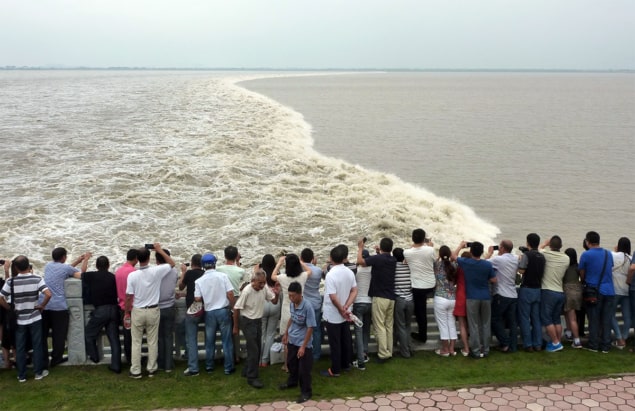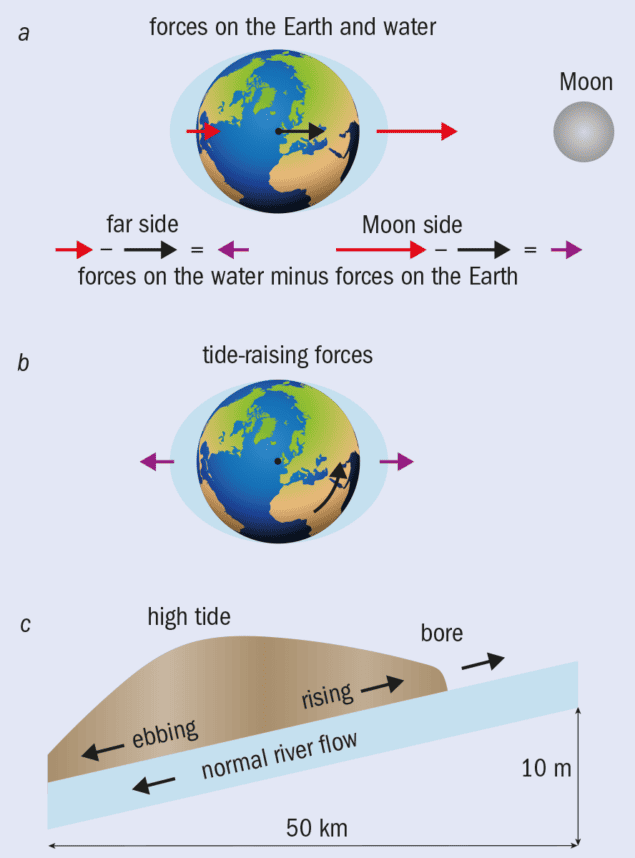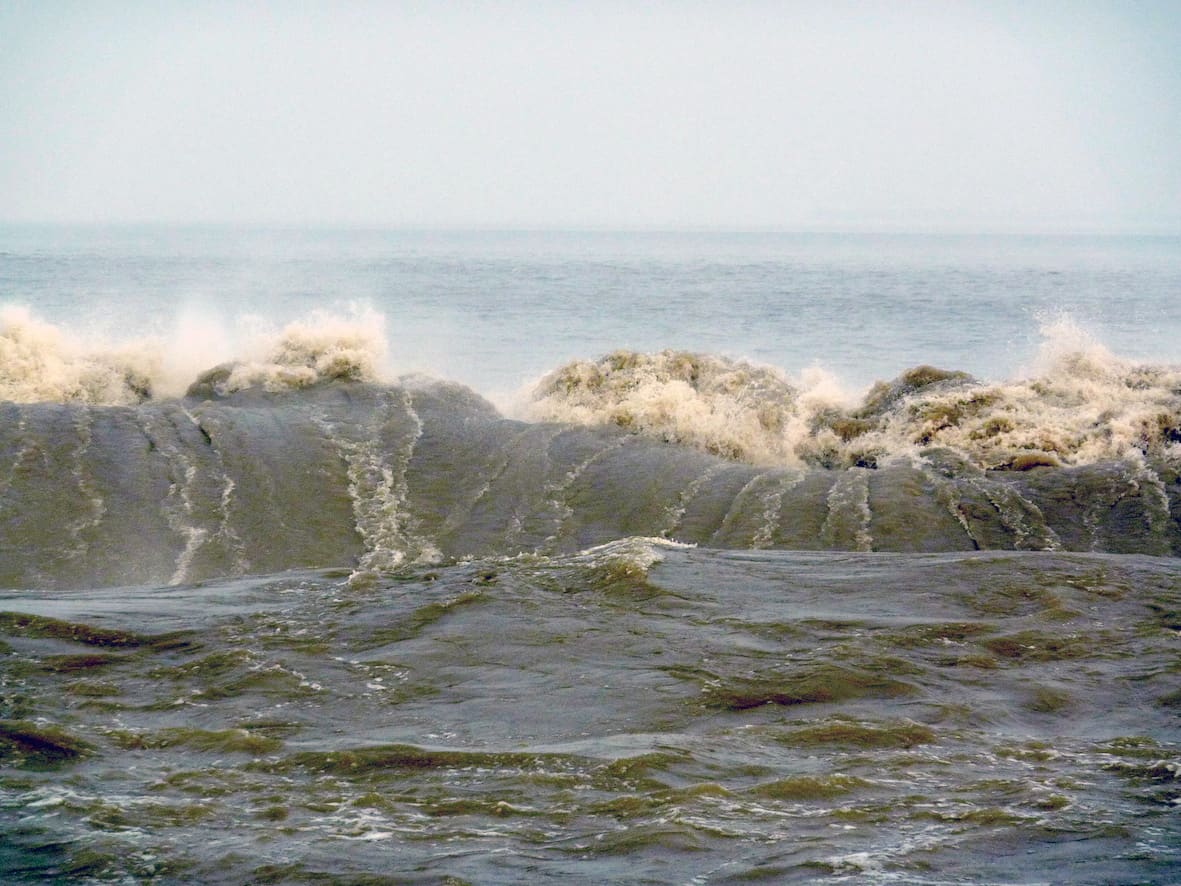Occurring on only a few dozen rivers around the world, tidal bores are as rare as they are intriguing. Michael Berry outlines the science behind this natural phenomenon and describes his sighting in China of one of the most spectacular bores of them all

One of the great sights of the Bristol area in the UK is the tidal bore on the River Severn – a wave that steepens and grows as the tide advances inland towards the city of Gloucester. Marking the beginning of the incoming tide, this giant wave is pulled up-river by the Moon’s gravity. I like to see the bore at night. As it approaches, the effect of the distant but then growing roar is magical – and there is plenty of light from Gloucester (and from the Moon when it is visible) to watch the bore as it passes by.
We can enjoy the spectacle of the bore, but understanding it raises some questions. Why are there two tides each day – not just one, in the water on the side of the Earth that faces the Moon? Of the more than 700 tides each year, why does a bore on the Severn occur during at most 50 of them, rather than all? And why does the Moon play a role anyway, given that the Sun’s gravity is nearly 200 times stronger?
The fundamental fact is that the force that raises the tide is not simply the gravity from the Moon and the Sun. It would be, if the Earth were held fixed in space by an imaginary cosmic vice. But the solid Earth is not fixed; it moves in an orbit round the Sun, perturbed by a slight wobble caused by the Moon. The tide-raising force is the difference between the force on the water and the force on the solid Earth. And the force attracting the water on the side of the Earth facing the Moon is greater than that on the solid Earth, while the force on the water on the side of the Earth away from the Moon is less than that on the solid Earth (figure 1a).
The tide-raising force therefore points outwards, leading to two tidal bulges on opposite sides of the Earth (figure 1b). As the Earth turns, a given geographical location experiences a bulge twice each day, leading to the two tides. Quantitatively, the tide-raising force is the gradient of the forces from the Sun and Moon: it is therefore an inverse-cube force from each, rather than the familiar inverse-square. And this tide-raising force from the Moon is about twice that from the Sun.
The arrival times and heights of bores cannot be predicted precisely, as these are sensitive to the amount of water already flowing downriver
The half-strength tidal force from the Sun is far from negligible and makes the height of the tides sensitive to astronomical alignments. Tides are stronger when the Sun and Moon are almost in line: at full and new Moon, and when the inclined orbit of the Moon intersects that of the Earth along a line pointing to the Sun. The effect is enhanced when the Moon and Earth are closest to their parent bodies along their elliptical orbits. Unlike eclipses and other astronomical phenomena, the arrival times and heights of bores cannot be predicted precisely, because these are sensitive to the amount of water already flowing downriver. (Don’t therefore be fooled by seemingly precise arrival-time predictions you can find online.) The most impressive bores occur at particularly high tides after a period when there has been no rain for several days.

The familiar tides at the seashore rise and fall gradually, over several hours. (The waves we see breaking on the shore are caused by winds, not tides.) What is different about rivers that host tidal bores – making bores sensitive to geography as well as astronomy – is that they are open to a large ocean and get narrower and shallower over a long distance upstream. The speed of waves on water is limited by the depth: √(gh), where g is the acceleration due to gravity and h the depth. The crest of the tide as it travels upriver gets deeper than the trough, so it travels faster, generating a wave that gets steeper, eventually with a fairly sharp front (figure 1c).
This difference of speeds between the crest and trough is a simple example of nonlinearity – the mathematical phenomenon that underlies all fluid-mechanical analyses of the formation and shape of the bore. But no mathematical treatment has captured the variety of shapes of the bore at different places along the river. The wave can break, tumbling as it crashes against the banks. Elsewhere, the bore advances upstream in a stately procession of smooth waves behind the front; under moonlight, its mirror surface gleams like liquid mercury. Mathematical models emphasize different features, for example as a moving shock wave, smoothed with a few undulations behind.
One question people often ask is whether a bore is a soliton. The answer is no, because a soliton is a wave whose height is the same on both sides of its peak, whereas the arrival of a bore is the beginning of the tide: the water is deeper behind the bore than in front of it. A striking aspect of a bore is that after it passes, as the tide continues to rise for about an hour, the river flows backwards – upstream but downwards. The smooth downstream flow before the bore passes contrasts with the wildly turbulent tide rushing upstream afterwards.
Destination China
The tidal bore on the River Severn is caused by the extraordinary tidal range in the Bristol Channel into which it flows. It is the world’s second highest, and can be as much as 17 m. The associated bore starts about 20 km upstream from the road bridges linking England and Wales at the mouth of the Severn and continues for another 20 km, and its height rarely exceeds 1 m. In the UK there are several other bores – on the rivers Parrett near Bridgwater and Dee near Chester, for example. In France, there used to be a bore on the Seine near Caudebec-en-Caux, le mascaret, but this largely disappeared after extensive dredging in the 1960s. In Brazil, the pororoca is a dramatic bore on the Amazon and some of its tributaries, holding the world record for long-distance surfing: about 12 km.
In September 2014, however, I was privileged to see the world’s largest tidal bore: the “Silver Dragon” near Hangzhou in south-east China, on the Qiantang river, the mouth of which opens out towards Shanghai. My host was Huan-Qiang Zhou, a physicist from Chongqing, a thousand miles to the west, whom I knew through the Journal of Physics A, which is published by the Institute of Physics (along with Physics World). Hangzhou is his home city and Zhou’s generous arrangements involved finding a local “fixer” who booked our hotels and meals, selected prime locations to view the bore, and decided on the best times to do so.
Tidal bores occur roughly twice a day, separated by a gap of 12 hours and 25 minutes. We saw the Silver Dragon six times: by day and by night over three days. It is a major tourist attraction; local media estimated that on the day of the biggest bore, more than 100,000 people lined the banks to watch it, and at prime locations our host had to buy tickets to reach the river bank. I saw no non-Chinese people other than the Australian physicist who accompanied us.

As with the Severn bore, you hear the low roar of the wave before you see it. The Qiantang river is almost 3 km wide, in contrast with the mere 50 m width of the Severn near Gloucester, so the wave is louder, and the roar is audible a full 20 minutes before the bore is glimpsed as a thin white line in the distance. There is great anticipation as the angry wave approaches, before a shout goes up as it rushes by. At night, there were fewer people watching the Qiantang bore and, because of the way sound refracts differently when the ground is colder, its roar could be heard even earlier.
Several long walls jut out perpendicular to the river bank. Standing on one of them, we saw the wave approach head-on, crash into the wall and then reflect. This reflected wave was an awesome sight, hugely amplified as it receded and interfered coherently with the still-advancing tide. The Severn bore can be reflected too, after it hits the weir upstream from Maisemore, which is usually the limit of its journey. Standing on Maisemore Bridge, I once saw a tiny reflection, a few centimetres high, several minutes after the bore had passed.
The bore moves up the Qiantang river at speeds varying between 10 km/h and 20 km/h. On the last night, we chased it for tens of kilometres, following it by car until 3 a.m. The fixer chose a final viewing location where the bore crashed against another wall. As we parked, seconds before the bore arrived, police rushed alongside on motorcycles, screaming at us to shift our car, and ourselves, several tens of metres away. With my mistrust of authority, I thought they were being unnecessarily officious. But they were right, because the reflected wave smashed through the protective chain-link fence, and would have drenched us and the car, probably knocking us over.

With the interval of 12 hours and 25 minutes between bores, and long drives between viewings in several different places, our sleep patterns were disrupted, leaving us permanently exhausted. Our discomfort was somewhat alleviated by the luxurious hotels chosen by the fixer. One deserves mention as an attraction in itself: the Ningbo Hiatian Yizhou Hotel, which is spectacularly located on the Qiantang river as it opens out into its estuary. The building lies in the middle of a bridge spanning the river, claimed to be the world’s longest over clear water – nearly 40 km.
Experiencing unification
A primary aim of physics is to unify the different fundamental forces. A giant step in this direction was Maxwell’s unification of electricity, magnetism and light, in his electromagnetic theory that now underpins our communications technology. The effort continues, with attempts to unify gravity with the strong and electroweak interactions that act on microscopic scales. But we should not forget the first unification, which was Isaac Newton’s discovery that the force that holds us to the ground, the force that keeps the Moon in its orbit, and the force that drives the tides, is in fact one force: gravity.
Witnessing a tidal bore, we experience this unification directly.


